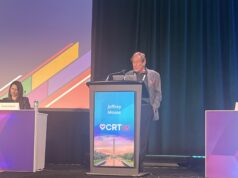According to a study published in JACC: Cardiovascular Interventions, patients undergoing left main coronary artery percutaneous coronary intervention (PCI) had better outcomes when the procedure was performed by experienced, high-volume operators—even though the patients treated by the experienced operators tended to have more complex and extensive heart disease.
Yuejin Yang (Department of cardiology, Fu Wai Hospital, Beijing, China) and others examined the records of 1,948 patients who underwent left main PCI between January 2004 and December 2011, with 25 operators performing the procedure. Of those patients, 1,422 (73%) were treated by seven experienced, high-volume operators and 526 (27%) patients were treated by 18 less experienced, low-volume operators. High-volume operators performed a mean of 25 left main PCIs per year, while low-volume operators performed a mean of four left main PCIs per year.
Patients treated by high-volume operators had better short- and long-term outcomes. Death within 30 days was 0.6% with high-volume operators and 2.1% with low-volume operators. There was no significant difference in rates of myocardial infarction and stroke over the same time period were lower in patients treated by high-volume operators. Patients of high-volume operators also had lower risks of cardiac death and all-cause mortality, as well as a trend toward a decreased risk of stent thrombosis.
After three years, patients treated by experienced, high-volume operators experienced a significantly lower risk of cardiac death. These trends were observed even though patients who underwent left main PCI with a high-volume operator had more extensive coronary artery disease and underwent more technically complex procedures. High-volume operators were also more likely to use first-generation, rather than superior second-generation, drug-eluting stents. This is the first study to conclusively demonstrate that operator experience impacts the prognosis of patients who undergo high-risk PCI.
Yang comments: “Our findings suggest that high-risk and complex procedures, such as left-main PCI, should be reserved to a limited number of experienced operators in order to achieve the best outcomes. Alternatively, less experienced operators could perform left main PCI under the close supervision and mentorship of an experienced operator until they acquire sufficient skill and technique to become independent.”
In an editorial comment accompanying the study, Ralph G Brindis and Gregory J Dehmer, examined data from the American College of Cardiology’s National Cardiovascular Data Registry’s (NCDR) CathPCI Registry to determine the amount of left-main PCI’s performed by high- and low-volume operators in the USA. They found that for left main PCI’s performed between April 2015 and March 2016, only 1% of operators would be considered high-volume based on the study’s criteria of having performed at least 15 left main PCIs per year for at least three consecutive years. Additionally, these operators performed only 8.4% of these annual procedures in the USA.
“These numbers are a stark contrast compared with the results of the study by Yang and colleagues and perhaps should be a wake-up call to the interventional community,” Brindis and Dehmer say, adding: “The concept of a ‘Centre of Excellence’ has been widely promoted and, frankly, overused to the point it now has little meaning. The study findings show that a ‘Center of Excellence’ for left-main PCI should be one with experienced, high-volume operators that can demonstrate good outcomes.”










